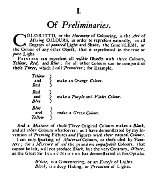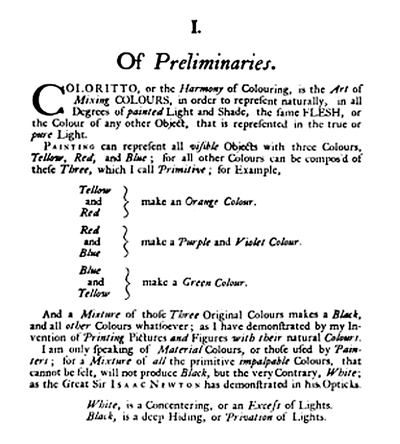
Jacob Christoph Le Blon
Encyclopedia

Germany
Germany , officially the Federal Republic of Germany , is a federal parliamentary republic in Europe. The country consists of 16 states while the capital and largest city is Berlin. Germany covers an area of 357,021 km2 and has a largely temperate seasonal climate...
painter and engraver who invented the system of three- and four-colour printing, using an RYBK color model similar to the modern CMYK system.[2] He used the mezzotint method to engrave three or four metal plates (one each per printing ink) to make prints with a wide range of colours. His methods helped form the foundation for modern colour printing.
Biography
On his father’s side Le Blon descended from Huguenots fleeing France in 1576, having settled in Frankfurt. His grandfather Christof Le Blon married Susanna Barbara Merian daughter of the artist and engraver Matthäus MerianMatthäus Merian
Matthäus Merian der Ältere was a Swiss-born engraver who worked in Frankfurt for most of his career, where he also ran a publishing house.-Early life and marriage:...
(1593–1650). Le Blon is reported to have received training as a young man from the Swiss painter and engraver Conrad Ferdinand Meyer (1618–1689) in Zurich but there is no documentary evidence.[1] It is generally agreed that Le Blon had an extended stay sometime between 1696 and 1702 in Rome where he is reported to have studied art under the painter Carlo Maratta
Carlo Maratta
Carlo Maratta or Maratti was an Italian painter, active mostly in Rome, and known principally for his classicizing paintings executed in a Late Baroque Classical manner. Although he is part of the classical tradition stemming from Raphael, he was not exempt from the influence of Baroque painting...
(1625–1713). There he became acquainted with the Dutch painter and engraver Bonaventura van Overbeek (1667–1706) who created an extensive work of views of the antiquities of Rome, published posthumously in 1708 and containing a portrait of Overbeek attributed to Le Blon.[4] Encouraged by van Overbeek, Le Blon moved to Amsterdam, presumably in 1702, where he worked as a miniature painter and engraver. In 1705 he married Gerarda Vloet with whom he had two sons that appear to have died in infancy.
In 1707 Le Blon issued a short publication in Dutch on the forms of the human body.[5] In 1708 and 1709 he is known to have made colorant mixing experiments in Amsterdam and in 1710 he made his first color prints with yellow, red, and blue plates.[2] While in Amsterdam he became acquainted with Arnold Houbraken
Arnold Houbraken
Arnold Houbraken was a Dutch painter and writer from Dordrecht, now remembered mainly as a biographer of artists from the Dutch Golden Age. He had ten children. His son Jacobus Houbraken was an engraver of portraits and book illustrations, including books by his father...
, who quoted him as a source of information on German painters for his Schouburg, later published after Houbraken's death in 1718. Le Blon's wife died in 1716 and in 1717 he moved to London where he received royal patents for the three-color printing process and a three-color tapestry weaving process. The tapestry process involved using white, yellow, red, blue, and black fibers to create images.[3] The printing process involved using three different intaglio plates, inked in different colours. In 1722 he published a small book, Coloritto, in French and English.[6] In it he stated that “Painting can represent all visible objects with three colors, yellow, red, and blue” (pp. 6, 7). During his stay in England he produced several dozen of three- and four-colored images in multiple copies that initially sold well in England and on the continent. In the long run his enterprise did not succeed, however, and Le Blon left England in 1735, moving to Paris where he continued producing prints by his method. During his last years several sequences of prints were produced and sold showing the different steps of his printing process, such as a portrait of the French Cardinal de Fleury.[7] In 1740 he began work on a collection of anatomical prints for which he had a solid list of subscribers. When he died in 1741 in Paris he left a 4 ½ year-old daughter, Margueritte, as sole inheritor.[1] A detailed description of Le Blon’s work was published in 1756 by Antoine Gautier de Montdorge who befriended him during his final years in Paris.[8]
Le Blon’s method required experience in deconstructing a colored image into its presumed primary chromatic components and understanding the effects of superimposing printing inks in certain areas, for which extensive trial and error work was required. Le Blon’s process was practiced in France after his death and progressed in the early-mid-19th century into chromolithography
Chromolithography
Chromolithography is a method for making multi-color prints. This type of color printing stemmed from the process of lithography, and it includes all types of lithography that are printed in color. When chromolithography is used to reproduce photographs, the term photochrom is frequently used...
. What was required, however, is a methodology to break images objectively into color components which became possible with the invention of color photography in the second half of the 19th century and the invention of half-tone printing in the late 19th century.

